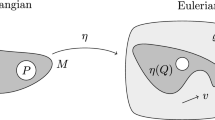Abstract
A method to develop unified artificial boundaries for problems coupling static effect and dynamic effect is proposed. Based on the dynamic viscous-spring artificial boundary and the fundamental solution of static problems in elastic half space, a unified viscous-spring artificial boundary for 3-D static and dynamic applications is established.
Similar content being viewed by others
References
Lysmer, J., Kulemeyer, R. L., Finite dynamic model for infinite media, Journal of Engineering Mechanics, ASCE, 1969, 95: 759–877.
Deeks, A. J., Randolph, M. F., Axisymmetric time-domain transmitting boundaries, Journal of Engineering Mechanics, ASCE, 1994, 120(1): 25–42.
Liu Jingbo, Lu Yandong, A direct method for analysis of dynamic soil-structure interaction based on interface idea, in Dynamic Soil-Structure Interaction (eds. Zhang, C. H., Wolf, J. P.) Beijing: International Academia Publishers, 1997, 258–273.
Liu Jingbo, Lu Yandong, A direct method for analysis of dynamic soil-structure interaction, China Civil Engineering Journal (in Chinese), 1998, 31(3): 55–64.
Wang Zhenyu, Computational theory of dynamic response of large structure-soil systems and its application, Ph. D Dissertation. Tsinghua University, Beijing, 2002.
Liao Zhenpeng, Introduction to Wave Motion Theories in Engineering (in Chinese), Beijing: Science Press, 2002.
People’s Republic of China. GB50267-97, Seismic Design Code of Nuclear Power Plants (in Chinese), Beijing: China Planning Press, 1998.
Liu Jingbo, Wang Zhenyu, Zhang Kefeng et al., 3D finite element analysis of large dynamic machine foundation considering soil-structure interaction, Engineering Mechanics (in Chinese), 2002, 19(3): 34–38.
Wang Zhenyu, Liu Jingbo, Pei Yuxiao et al., Theoretical and experimental study on micro-vibration reduction of large dynamic machine foundation, Chinese Journal of Geotechnical Engineering (in Chinese), 2002, 24(3): 363–366.
Xiong Hui, Zou Yinsheng, Xu Zhenyu, The simulation of interactive effect on pile-soil-structure by whole dynamic finite element method in layered soil field (in Chinese), China Civil Engineering Journal, 2004, 37(9): 55–61.
Kellezi, L., Local transmitting boundaries for transient elastic analysis, Soil Dynamics and Earthquake Engineering, 2000, (19): 533–547.
Lysmer, J., Analysis method in soil mechanics, in Translations on Earthquake Engineering and Soil Dynamic Problems (in Chinese), Beijing: Seismic Press, 1985.
Wolf, J. P., Song, C., Finite-Element Modeling of Unbounded Media, New York Wiley, 1996.
Xu Zhilun, Elasticity Mechanics (in Chinese), Beijing: Higher Education Press, 1990.
Pekeris, C. L., The seismic surface pulse, Proceedings of the National Academy of Science, 1955, 41: 469–480.
Author information
Authors and Affiliations
Corresponding author
Rights and permissions
About this article
Cite this article
Liu, J., Li, B. A unified viscous-spring artificial boundary for 3-D static and dynamic applications. Sci. China Ser. E-Technol. Sci. 48, 570–584 (2005). https://doi.org/10.1360/04ye0362
Received:
Issue Date:
DOI: https://doi.org/10.1360/04ye0362




